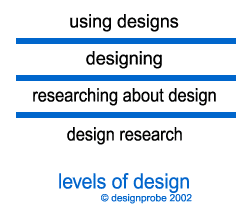|
 |
Design Research
To distinguish the type of work we undertake at designprobe, we
have created the following model that distinguishes between four
levels of design.
Levels of Design
1 Using Designs
This first level of design is ‘the use of design’. If
you are reading this note sitting inside a building, we could say
you are ‘using the design of the building’ in which you
are in. You may also be ‘using the design of a chair’
upon which you may be sitting as well as the ‘design of a computer’
etc. if you are reading this via the Internet.
2 Designing
The second level of design is ‘designing’ itself. For
example, an architect designs buildings, a graphic designer designs
graphic imagery, a website designer designs websites. The intention
of this level is to create artifacts for immediate use or for production.
We make a distinction between the making of design prototypes and design research. For example, not so long ago the design of motor cars involved making full scale clay models. We tend to think of this as part of ‘designing’ because the immeditate intent of this process is to develop a workable design suitable for production and use.
 3
Researching about Design 3
Researching about Design
The third level of design is ‘researching about design’.
For example, this may include interviewing designers, analysing
and comparing various designed objects, or reviewing design trends.
The intention of this level of design is create new insights about
design and does not directly involve the creation of new artifacts.
A lot of academic research occurs at this level where the researcher
is neither practising design or making new artifacts (what we call
‘design research’). The researcher working at this level
is often analysing existing objects or ideas and presents their
results as information (eg. An article or book).
4 Design Research
The fourth level of design is ‘design research’. We
consider the requirements of this level to be ‘the creation
of artifacts not intended for production or use’.
Typically we think of research being related to science. When a
scientist undertakes research they start with a hypothesis and then
undertake experiments to verify or disprove their hypothesis. The
result of the experiments is potentially a new understanding of
how the world works. Our approach is similar, except instead of
scientific experiments we undertake ‘art based’ experiments
through creating art objects.
The intention of design research is the same as research in the
scientific world: to create new conceptual models. One key difference
between science and art is that science seeks an objective description
of how nature works, whereas the research artist looks to create
new perceptual responses to how the world could be. We believe that
research undertaken through art in this way is as powerful as the
scientific model that is practised intensively around the world.
From research in science and art, new technologies emerge. For example, Einstein was awarded the Nobel Prize for discovering the photoelectric effect whereby light emissions strike metals and produce electricity. From this pure research solar cells were invented. Similarly, Einstein was devastated at the invention of the atomic bomb because he knew that it had been invented through the use of his Theory of Relativity.
In art, the connections between technological inventions are often
less obvious. Several that stand out are the development of the
camera from the perspective modelling system and the development
of the computer screen from the Pointillist paintings of Seurat
and others of the late 19th century.
The prolific inventions of Buckminster Fuller derive from his combination of design research and scientific research. He is perhaps best known for his invention of the geodesic geometry system which was later built as a geodesic dome and is commonly used as a ‘space frame’ in large building spans.
(For a further explanation refer to "The
Creation Model")
|
 |
| |
|
|

|
|

![]()
